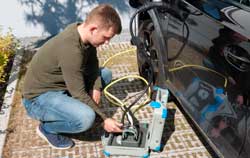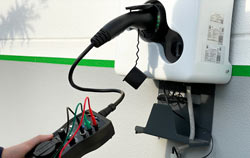Testing an EV Charging Station / E-charging Station
The quite natural everyday handling of electric current and the high safety precautions common in this country mean that users are not always aware of the dangers of the electric current.  Not only some mistakes in planning and installation of the electrical systems, but also wear and tear, ageing, environmental influences and defects with other causes can lead to protective measures becoming ineffective. To prevent personal injury and damage to property and to ensure the intended function of the electrical installations, there are therefore a number of mandatory regulations.
Not only some mistakes in planning and installation of the electrical systems, but also wear and tear, ageing, environmental influences and defects with other causes can lead to protective measures becoming ineffective. To prevent personal injury and damage to property and to ensure the intended function of the electrical installations, there are therefore a number of mandatory regulations.
An EV charging station is usually connected to the three-phase alternating current with 400 volts in order to be able to generate high charging power. So that the installation or operation of the charging stations did not lead to endangering people, overloading the grid or to the failure of the power-operated equipment and systems, the Charging Station Ordinance was passed in 2016 for publicly accessible charging points in addition to the requirements that apply to every EV charging station. It lays down the minimum technical requirements for safety and also for general accessibility.
Initial and repeat tests
Every EV charging station belongs to the electrical installations on which the initial tests according to DIN VDE 0100-0600 (IEC 60364-6) and repeat tests according to DIN VDE 0105-0100/A1 (IEC 60364-6, Clause 6.5) and VDE 0122-1 (IEC 61851-1) must be carried out by the qualified electricians.  The tests of the e-charging station include inspection, measurement and testing in accordance with the standard specifications with additional consideration of the specifications in the manufacturer's technical documentation. The performance of the tests and their results must be documented in a test report. The tests are primarily intended to determine safety against electric shock and thermal effects, against the effects of lightning and over-voltages, but also the functionality of the system. They are intended to ensure that any defects that may exist are discovered early on and can be remedied before any damage occurs.
The tests of the e-charging station include inspection, measurement and testing in accordance with the standard specifications with additional consideration of the specifications in the manufacturer's technical documentation. The performance of the tests and their results must be documented in a test report. The tests are primarily intended to determine safety against electric shock and thermal effects, against the effects of lightning and over-voltages, but also the functionality of the system. They are intended to ensure that any defects that may exist are discovered early on and can be remedied before any damage occurs.
The first test steps include the visual inspection, the test of continuity and low impedance of the protective conductor and the insulation test. After that, the active measurements are taken at the set charging voltage, including the loop impedance and, for the residual current devices, the RCD tripping time and the RCD tripping current. If a counter is present, the rotating field direction and the correct counter start-up are also checked. To ensure that the communication with the connected vehicle functions correctly, the transmitted CP signal is also checked.
Adapter for simulating charging processes and faults for the measurements
When testing the e-charging station, all the charging states that actually occur should be tested reliably and with the repeatable accuracy without a vehicle. Without the vehicle being connected, however, the charging station must not emit any voltage. Special test adapters can not only simulate the various vehicles charging levels and charging cables. The EVSE adapters also enable convenient measurement of the voltage and signal cables with conventional installation testers simply via the plug connection of the EV charging station.
| CP traffic jams – vehicle charge levels | Resistance CP-PE |
|---|---|
| A No vehicle connected | open |
| B Vehicle connected | 2700 Ohm |
| C Vehicle ready for charging (without ventilation) | 880 Ohm |
| D Vehicle ready for charging (ventilation required) | 240 Ohm |
| E CP error | CP-PE short circuit |
| PP status - charging cable type | Resistance PP-PE |
|---|---|
| NC – no cable connected | open |
| 13 amps | 1500 ohms |
| 20 amps | 680 ohms |
| 32 Amps | 220 Ohms |
| 63 Amps | 100 Ohms |
As a rule, the EVSE adapters are additionally equipped with a function to simulate an earth fault / PE fault. In the event of this and a CP fault (CP status E), the charging process must be interrupted immediately and the plug-in connection of the EV charging station must be disconnected from the power supply. Some adapters also have a manual PE pre-test, which allows the user to check whether the PE line of the EV charging station is safely earthed by pressing a button before the actual tests.




